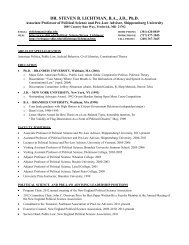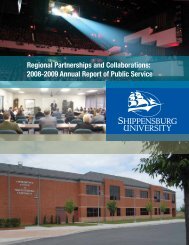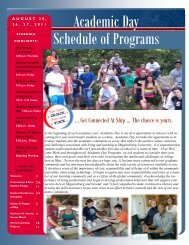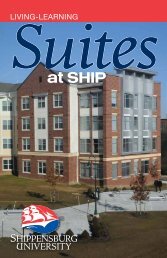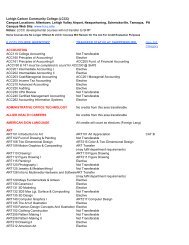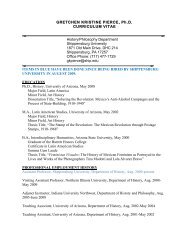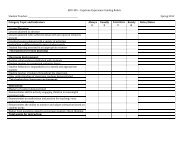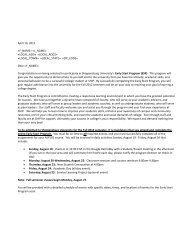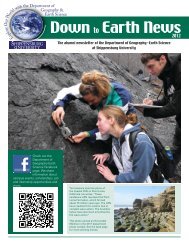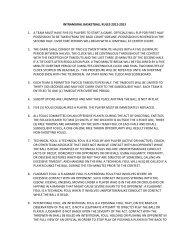13The Residential Urban Landscapeas a Frontier for WaterConservationR o l s t o n St . HilaireN e w Me x i c o St a t e <strong>University</strong>In the United States, growing populations inevery community will face different water supply anddemand issues. And the urban residential landscapemight be the frontier where water conservation issuescollide. Irrigation is the largest user of freshwater in theUnited States (Hutson et al. 2004). Irrigation used foragricultural and horticultural practices averages 2.48acre-feet per acre (Hutson) and accounts for 81 percentof the consumptive use of water (Solley et al. 1998)in the United States. Traditionally, this consumptiveuse estimate includes freshwater irrigation on crops,parks, golf courses, and other recreational areas. But,increasing urbanization could mean the water used toirrigate the urban landscape will become an increasinglyimportant factor in consumptive water use estimates.Urban landscape irrigation may not necessarily causean increase in fresh water withdrawals from existingsources, but the consumptive water of the urban landscapeas a proportion of the total consumptive use mayincrease. For example, in Arizona, agricultural wateruse is projected to decline, whilst municipal use (eg.residential water use) will double over the next 50 years(Unruh and Liverman 2008).On average, yearly residential water use ranged froma low of 55 gallons per day per person in the temperatemesic state of Wisconsin to a high of 207 gallons perday per person in the arid state of Nevada (Emrath2000). This difference in water use indicates thatclimate-related differences in outdoor water utilizationcontribute significantly to the high water use in aridwestern states (Emrath, 2000). However, landscapeirrigation can average 40 to 70 percent of residentialwater use in the United States (Ferguson 1987), makingit clear the urban landscape commands a significantportion of residential water use.Although total fresh water withdrawals have flatlinedsince 1950 and remained at about 80 percentsurface water and 20 percent ground water (Hutsonet al. 2004), the drivers that are tending to shiftconsumptive water use to the urban landscape areincreasing. Urban and suburban population growth hasdramatically altered the balance between consumptivewater demand and available supply. This is evident inportions of the arid and semiarid regions of the westernUnited States where rapid expansion of urban areasand increases in population have occurred during thelast few decades. Between 2000 and 2008, the westernstates of Nevada, Arizona, and Utah experiencedpercentage population increases of 30, 27, and 22percent, respectively. Although California’s populationgrowth ranked eighteenth among the states, it is themost populous state (US Census Bureau 2008). Thispopulation growth demands creative strategies to satisfythe increased demand for landscape irrigation fromexisting sources. Some of those existing water sourcesare already fully allocated or are rapidly becoming fullyalloted. For example, two decades ago the entire 7.5million acre-foot of water of the lower Colorado Riverbasin (Arizona, California, and Nevada) became fullyallotted for the first time (Unruh and Liverman 2008).That the urban landscape might be a frontier forwater conservation is clearly illustrated with the caseof Nevada. In addition to Nevada having the highestpopulation growth in the United States, the LasVegas Valley in Nevada is one of the fastest growingmetropolitan areas in the United States (Sovocool et al.2006). Together with population growth, the increasingnumber of people who visit Las Vegas because of itstourism and gaming industries has mandated a seriouscommitment to managing the regions water supplyto ensure adequate future supplies (Sovocool 2006).Rolston St. Hilaire is a professor in the Department of Plant and Environmental Sciences, at New Mexico State <strong>University</strong>in Las Cruces, New Mexico. He teaches landscape horticulture and his research focuses on plant stress physiologyand the efficient use of water in urban landscapes.
14 PROTEUS: A Journal of IdeasLandscape irrigation contributes to most of southernNevada’s consumptive water use (Sovocool et al. 2006)which prompted the Southern Nevada Water Authority(SNWA), a regional collaborative of seven public waterand waste water agencies, to craft strategies aimed atconserving water in the residential landscape.The SNWA showed single family residencies withxeric landscapes use 76 percent less water than thosewith turf-dominated landscapes. Xeric landscapes werecomposed of desert-adapted shrubs, trees, ornamentalgrasses, and crushed rock mulch (Sovocool et al. 2006).Total water use of households with xeric landscapesaveraged 96,000 gallons less than homes with turf-typelandscapes. Using xeric landscapes might be one way toconserve water in the urban environment.While xeric landscapes are likely to flourish inNevada because of their documented water conservationbenefits, the use of xeric landscapes as a waterconservation measure could influence urban landscapingin other regions of the United States. For example,the increasing frequency of summer droughts in partsof the United States, such as the Northeast, that areunaccustomed to droughts (Wolfe et al. 2008), willplace increasing demand for landscape irrigation andlandscapes that conserve water. Additionally, expectedincreases in the earth’s average temperature will increaseevapotranspiration which could exacerbate droughtconditions (NDRC 2008). Higher temperatures willincrease evaporation from outdoor water features andelevate evapotranspiration from plants. Both of thoseoccurrences will augment the demand for water inurban landscapesBefore xeric landscapes can be widely adopted,barriers to their adoption must be conquered. One ofthe highest rated barriers to installing xeric landscapesis concern about their aesthetics (Hurd et al. 2006).Consumers may select xeric landscapes as a way toconserve water if those landscapes can offer similarfunctions as traditional landscapes (Spinti et al., 2004).So, landscape designers and planners must incorporatethe same design elements found in traditionallandscapes into xeric landscapes to ensure that xericlandscapes are appealing.As a frontier for water conservation, perhapsthe greatest gain in water conservation in the urbanenvironment will be made by improving the efficiencyof landscape irrigation delivery systems. In the broadestsense, landscape irrigation is the application of waterto land areas that supply the water needs of ornamentaland landscape plants (St. Hilaire et al. 2008). Becauselandscape irrigation involves an engineered physicalsystem that requires user input, skilled installation, andperiodic maintenance, the risk of inefficiency is high. Abreakdown in any one of these items or activities causesreduced irrigation efficiency. So, improving irrigationefficiency must be at the heart of any strategy thatseeks to guarantee the most efficient use of water in theurban landscape.Significant gains in urban landscape irrigationefficiency will be made if landscape water budgetsare developed, irrigations are scheduled correctly, anduser-friendly technology is infused into the landscapeirrigation process. An urban landscape water budget,also known as its maximum applied water allowance,can be calculated to provide a quantitative estimate ofan urban landscape’s water budget (St. Hilaire et al.2008). Residential urban landscapes are heterogenousmixes of turfgrass, woody, and herbaceous plant speciesthat are valued for their aesthetics, not their production.So, crop water budgets, steeped in the concept ofoptimum growth and yield, are not relevant to theurban landscape (Shaw and Pittenger 2004). Ratherthan rely on water budgets calculations that have beendeveloped for crops, urban landscape professionals mustdevelop water budgeting tools that are unique to theurban landscape. Some urban residential landscapescan thrive with less water than is indicated from acalculated water budget. This fact alone offers a uniqueopportunity for water conservation in the urbanlandscape.User-friendly technology, such as smart controllersand soil moisture sensors can remove the decision toirrigate from the hands of the homeowner. Becausemost conventional in-ground irrigation systems areoperated by a controller that mandates operator (homeowner)intervention to adjust the daily or seasonalirrigation run times, most homeowners set the scheduleand do not seasonally adjust their irrigation schedules.This results in an over-irrigated residential landscapeduring periods of reduced plant water demand, such asthe fall to winter period (Davis et al. 2007).Some smart controllers will automatically adjustirrigation schedules based on weather conditions. Soilmoisture sensors can detect levels in soils and terminateirrigation events when soil moisture reaches setlevels. Smart controllers have been reported to reducesummertime applied water by up to 42 gallons per dayfor residential landscapes and up to 545 gallons perday for commercial landscapes (Irvine Ranch WaterDistrict 2008a). The widespread adoption of smartcontroller technology or the use of soil moisture sensorshas the potential to realize significant water savings.Saving water will become a significant piece offuture water management programs for rapidly growingpopulations (California Office of Water Use Efficiency2006) and has implications for how water is used inthe residential landscape. Environmental laws, craftedto limit ecosystem degradation, are constraining thedevelopment of new sources of water for the urbanenvironment (Dickinson 2008). Thus, utilization ofreuse water in the urban landscape is one strategycommunities can use to offset the lack of new watersources. Potential sources of reuse water includeeffluent, storm water runoff, and nursery runoff. Reusewater is more likely to be used to irrigate golf courses,parks, and roadway medians where public acceptance



